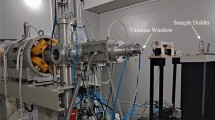Abstract
The mechanisms of the radiation defect formation in alkali halide crystals are studied in an extremely wide range of the absorbed radiation dose rate (101–1012 Gy/s). It is found that the power dependence of color centers accumulation is described by a curve with a maximum at a dose rate of about 1010 Gy/s. The electron and proton track parameters for ionic crystals are calculated in the context of the theory of ionization losses of charged-particle energy. Proceeding from the concept of the charged-particle track overlap, the theoretical relations are obtained that explain the radiation power effect in all dielectric materials including alkali halide crystals. The suppression of color center accumulation in these crystals under high-power electron irradiation is due to a more regular topography of the radiation defect formation.
Similar content being viewed by others
References
D. I. Vaisburd, ed., High-Energy Electronics of Solids [in Russian], Nauka, Novosibirsk, 1982.
A. A. Vorob’ev, Yu. M. Annenkov, A. M. Pritulov, et al., Paper No. B7337495-79, deposited at VNTIC, Moscow (1979).
E. Segre, Experimental Nuclear Physics, Vol. 1 [Russian translation], Inostrannaya Literatura, Moscow (1956).
Yu. M. Annenkov and A. M. Pritulov, Fiz. Tverd. Tela, 26, No. 3, 1391(1984).
Yu. M. Annenkov, A. P. Surzhikov, A. M. Pritulov, et al., High-Temperature Superconductivity [in Russian], Tomsk (1990).
Yu. M. Annenkov, T. S. Frangulian, A. M. Pritulov, and N. N. Aparov, Ogneupory, No. 5, 12 (1995).
Yu. M. Annenkov, N. N. Aparov, and T. S. Frangulian, in: Abstracts of Reports at Int.Conf. Radiation Effects in Insulators, Vol. 1, Nagoya, Japan (1993).
Yu. M. Annenkov, A. P. Surzhikov, A. S. Sigov, et al., Certificate of Copyright No. 1752153 (1992).
D. I. Vaisburd, A. A. Vorob’ev, and A. Melikyan, Atomnaya Energiya, 30, No. 6, 538 (1971).
Yu. M. Annenkov, Doct. Thesis in Phys.-Math. Sci., Tomsk (2002).
Yu. M. Annenkov and T. S. Frangulian, Abstracts of Reports at Conf. “Polymaterials-2001,” Moscow (2001).
P. D. Alekseev, Sov. Phys. J., No. 12, 134 (1969).
V. P. Kuznetsov, Determination of the Defect Relaxation Time in a Proton Track from the Dependence of the Defect Yield on the Beam Intensity, Author’s Abstract Cand. Phys.-Math. Sci. Dissert., Tomsk (2002).
D. I. Vaisburd and P. D. Alekseev, Sov. Phys. J., No. 11 (1971).
E. K. Zavadovskaya, Yu. M. Annenkov, and T. S. Frangulian, Sov. Phys. J., No. 11 (1969).
T. S. Frangulian, Investigation of Radiation Accumulation of Color Centers in KCl-KBr Solid Solutions, Author’s Abstract of Cand. Phys.-Math. Sci. Dissert., Tomsk (1971).
Yu. M. Annenkov, Investigation of Electric Properties of Alkali-Halide Crystals and Their Radiation Modification, Candidate’s Dissertation in Physical and Mathematical Sciences, Tomsk (1969).
A. B. Chormonov, Centers of Positron Annihilation and Positron Diagnostics of Radiation Defects in Irradiated Alkali-Halide Crystals, Author’s Abstract of Cand. Phys.-Math. Sci. Dissert., Tomsk (1987).
V. K. Biller, Accumulation of the Frenkel Cation Defects in Alkali-Halide Crystals Exposed to Charged Particles, Author’s Abstract of Cand. Phys.-Math. Sci. Dissert., Tomsk (1979).
Yu. M. Annenkov, V. K. Biller, Yu. I. Galanov, and T. S. Frangulian, in: Radiation-Induced Phenomena in Solids [in Russian], Sverdlovsk (1980), pp. 96–99.
Yu. M. Annenkov, V. F. Stolyarenko, and T. S. Frangulian, Izv. Vyssh. Ucheb. Zaved. Fizika, No. 6, 103–105 (1981).
Yu. M. Annenkov, V. F. Stolyarenko, and T. S. Frangulian, Sov. Phys. J., No. 2, 129 (1985).
Yu. M. Annenkov, T. S. Frangulian, and V. F. Stolyarenko, Fiz. Tverd. Tela, 29, No. 3, 925 (1987).
Yu. M. Annenkov, T. S. Frangulian, V. F. Stolyarenko, and A. M. Gornostaev, Sov. Phys. J., No. 8 (1988).
Yu. M. Annenkov, V. F. Stolyarenko, T. S. Frangulian, and Yu. I. Galanov, Vopr. Atomn. Nauki i Tekh., 4, No. 23, 77 (1982).
E. H. Weibenga, E. E. Havinga, and K. H. Boswijk, Adv. Inorg. Chem. Radiochem., 3, 133 (1961).
R. T. Williams, J. N. Bradford, and W. L. Faust, Phys. Rev., B18, No. 12, 7038 (1978).
Ch. B. Lushchik and A. Ch. Lushchik, Electron Excitation Decay and Defect Formation in Solids [in Russian], Nauka, Moscow, 1989.
P. Hovstad, Deviation from Stoichiometry, Diffusion, and Electrical Conductivity in Simple Metal Oxides [Russian translation], Mir, Moscow, 1975.
Author information
Authors and Affiliations
Additional information
__________
Translated from Izvestiya Vysshikh Uchebnykh Zavedenii, Fizika, No. 2, pp. 10–21, February, 2007.
Rights and permissions
About this article
Cite this article
Annenkov, Y.M. Particle track phenomena and radiation power effects at the formation of radiation defects in ionic crystals. Russ Phys J 50, 107–119 (2007). https://doi.org/10.1007/s11182-007-0015-6
Issue Date:
DOI: https://doi.org/10.1007/s11182-007-0015-6



